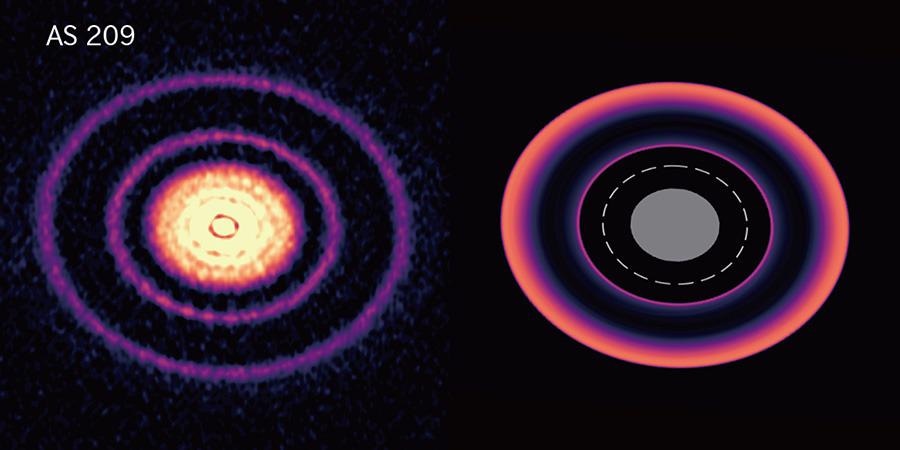One possible explanation for the rings and gaps noted in disks of gas and dust around young stars is the forming of planets. However, this theory cannot explain why it is unusual to identify planets that are linked with rings.
 A protoplanetary disk as observed by ALMA (left), and a protoplanetary disk during planetary migration, as obtained from the ATERUI II simulation (right). The dashed line in the simulation represents the orbit of a planet, and the gray area indicates a region not covered by the computational domain of the simulation. Image Credit: Kazuhiro D. Kanagawa, ALMA(ESO/NAOJ/NRAO).
A protoplanetary disk as observed by ALMA (left), and a protoplanetary disk during planetary migration, as obtained from the ATERUI II simulation (right). The dashed line in the simulation represents the orbit of a planet, and the gray area indicates a region not covered by the computational domain of the simulation. Image Credit: Kazuhiro D. Kanagawa, ALMA(ESO/NAOJ/NRAO).
New supercomputer simulations demonstrate that following the creation of a ring, a planet could shift away and leave the ring behind. Not only does this strengthen the planet theory for the development of rings, the simulations indicate that a migrating planet can produce a range of patterns corresponding to those actually noted in disks.
Young stars have been surrounded by protoplanetary disks of dust and gas. One of the world’s strongest radio telescope arrays, called ALMA (Atacama Large Millimeter/submillimeter Array), has noted a range of patterns of denser and less dense rings and gaps in such protoplanetary disks. Gravitational effects from planets forming in the disk are one theory to describe such structures. However, follow-up observations looking for planets next to the rings have been greatly unsuccessful.
In this study, a research group from Ibaraki University, Kogakuin University, and Tohoku University in Japan has utilized the world’s most robust supercomputer committed to astronomy, ATERUI II at the National Astronomical Observatory of Japan. This is to simulate the event of a planet moving away from its first formation site.
Their outcomes revealed that in a low viscosity disk, a ring developed at the first location of a planet does not move as the planet migrates inward. The team determined three clear phases. In Phase I, the first ring remains intact as the planet moves inward.
In Phase II, the initial ring starts to deform and a second ring begins to form at the planet’s new location. In Phase III, the initial ring vanishes, and only the latter ring is leftover.
Such outcomes help describe the reason why planets are rarely noted next to the outer rings, and the three phases determined in the simulations match well with the patterns that are observed in actual rings. Observations of greater resolution from next-generation telescopes will be better able to search for planets that are present close to the central star. This will help determine how well such simulations reflect reality.
Journal Reference:
Kanagawa, K. D., et al. (2021) Dust Rings as a Footprint of Planet Formation in a Protoplanetary Disk. The Astrophysical Journal. doi.org/10.3847/1538-4357/ac282b.